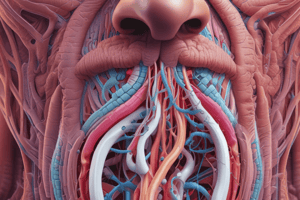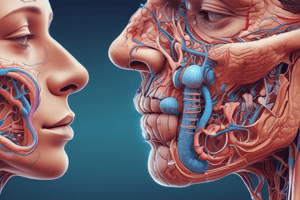Podcast
Questions and Answers
What is the main factor that affects breathing rate?
What is the main factor that affects breathing rate?
- Blood pressure
- CO2 concentration in the blood (correct)
- Oxygen concentration in the blood
- Body temperature
What stimulates chemoreceptors and increases breathing?
What stimulates chemoreceptors and increases breathing?
- A large drop in O2 levels (correct)
- An increase in blood pH
- A decrease in body temperature
- A drop in CO2 levels
What process involves inhalation and exhalation of amniotic fluid during fetal development?
What process involves inhalation and exhalation of amniotic fluid during fetal development?
- Fetal breathing (correct)
- Pulmonary secretion
- Amniotic respiration
- Embryonic ventilation
What leads to low CO2 levels and high blood pH?
What leads to low CO2 levels and high blood pH?
At high altitudes, what physiological response occurs to help carry a proper amount of oxygen?
At high altitudes, what physiological response occurs to help carry a proper amount of oxygen?
What gas has greater solubility than oxygen?
What gas has greater solubility than oxygen?
Where does gas exchange directly occur in the respiratory system?
Where does gas exchange directly occur in the respiratory system?
What is the function of the cilia in the nose?
What is the function of the cilia in the nose?
Which structure in the respiratory system closes to ensure food enters the esophagus?
Which structure in the respiratory system closes to ensure food enters the esophagus?
What initiates violent coughing if a foreign body is present in the respiratory system?
What initiates violent coughing if a foreign body is present in the respiratory system?
Which component of the respiratory membrane allows gases to cross by simple diffusion?
Which component of the respiratory membrane allows gases to cross by simple diffusion?
What causes pressure changes during breathing according to Boyle's law?
What causes pressure changes during breathing according to Boyle's law?
Which parameter is always lower than intra-alveolar pressure in the respiratory system?
Which parameter is always lower than intra-alveolar pressure in the respiratory system?
Flashcards are hidden until you start studying
Study Notes
Respiratory System
- The respiratory system has several functions, including conducting zone route for incoming and outgoing air, removing debris and pathogens, warming and humidifying incoming air.
- The nose is the major entrance and exit for the respiratory system, comprising bone and cartilage, with two nostrils separated by the nasal septum.
Nose and Pharynx
- The nose contains cilia that beat constantly to push mucus and debris towards the throat to be swallowed.
- Cold air slows cilia, leading to a runny nose due to mucus accumulation.
- The pharynx is a tube that continues with the nasal cavity and is divided into three regions: nasopharynx, oropharynx, and laryngopharynx.
- The nasopharynx should contain only air and is connected to the Eustachian tubes.
- The oropharynx contains both food and air, while the laryngopharynx splits into the larynx anteriorly and the esophagus posteriorly.
Larynx
- The larynx is a cartilaginous structure connecting the trachea and pharynx, formed by the thyroid cartilage, epiglottis, and cricoid cartilage.
- The epiglottis is an elastic cartilage that closes the tube to prevent food from entering the trachea.
Trachea and Bronchial Tree
- The trachea, or windpipe, extends to the lungs and is composed of 16 to 20 pieces of C-shaped cartilage connected by dense connective tissue.
- The bronchial tree branches into right and left bronchi at the carina, which has a special nerve to induce violent coughing if a foreign body is present.
- The bronchial tree directly involves the movement of air in and out of the lungs, in addition to mucus membranes that trap debris and pathogens.
Respiratory Zone
- The respiratory zone includes structures directly involved in gas exchange, starting at the respiratory bronchiole.
- Alveoli are clustered into alveolar sacs, and cells are highly permeable to gases, with alveolar macrophages providing protection.
Lungs
- The lungs perform oxygen and carbon dioxide exchange, are highly permeable to gases, and have two lobes on the left and three lobes on the right.
- Blood comes from the pulmonary tract, and the lining of the lungs is surrounded by a cavity enclosed by the pleura, visceral, and parietal layers.
Pulmonary Ventilation
- Pulmonary ventilation is the act of breathing, moving air in and out of the lungs, based on the relationship of pressure according to Boyle's Law.
- The thoracic wall compliance affects lung expansion, and the contraction of the diaphragm and intercostal muscles causes the pressure change, resulting in inspiration and exhalation.
Breathing and Respiratory Cycle
- Inspiration occurs when air enters the lungs, and expiration occurs when air leaves the lungs, with a respiratory cycle consisting of one sequence of inspiration and expiration.
- Quiet breathing is normal breathing, while forced breathing occurs during exercise or singing.
Lung Volumes and Capacities
- Tidal volume is the amount of air entering the lungs during normal breathing.
- Expiratory reserve volume is the amount of air forcefully exhaled after the end of a normal tidal expiration.
- Inspiratory reserve volume is the amount of air beyond the tidal inspiration that can be inhaled forcefully.
- Residual volume is the air left in the lungs after maximal expiration, keeping alveoli from collapsing.
- Total lung capacity is the amount of air possible after a forceful inhalation.
- Vital capacity is the amount of air used beyond the residual volume.
- Inspiratory capacity is the sum of tidal volume and inspiratory reserve volume.
- Functional residual capacity is the amount of air left after tidal expiration.
Anatomical and Alveolar Dead Space
- Anatomical dead space is the air that never reaches the alveoli, with no gas exchange occurring.
- Alveolar dead space is the air in alveoli that are unable to function due to disease or abnormal blood flow.
- Total dead space is all the air not being used in the gas exchange process.
Respiratory Rate and Factors Affecting Breathing
- Respiratory rate is the number of breaths per minute, controlled by the medulla oblongata.
- Factors affecting breathing include CO2 concentration in the blood, strenuous exercise, a large drop in O2, and increases in body temperature.
Gas Exchange and Transport
- Gas exchange occurs in the lungs and at the tissue level due to simple diffusion.
- O2 has a greater partial pressure, while CO2 has greater solubility.
- Most O2 travels attached to hemoglobin in an erythrocyte, with a saturation rate dependent on the percentage of hemoglobin filled with O2.
Fetal Development and High-Altitude Adaptation
- Embryonic development of the respiratory system begins around week 4, with respiratory bronchioles forming by week 16.
- Fetal breathing movements may begin by week 20, and the fetus can breathe around week 28.
- At birth, most fluid is removed from the lungs as the baby travels through the birth canal, and the first inhalation occurs within 10 seconds of birth, inflating the lungs.
- High-altitude adaptation leads to increased EPO release, producing more RBCs to carry O2.
Studying That Suits You
Use AI to generate personalized quizzes and flashcards to suit your learning preferences.




